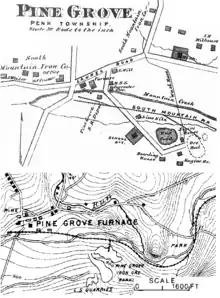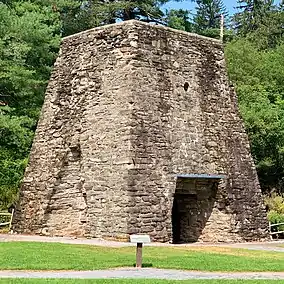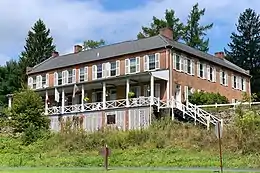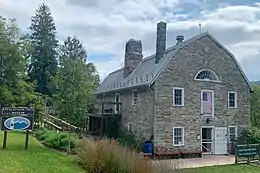Pine Grove Iron Works
The Pine Grove Iron Works was a smelting facility in southcentral Pennsylvania during the Industrial Revolution. The works is notable for remaining structures that are historical visitor attractions of Pine Grove Furnace State Park, including the furnace stack of the Pine Grove Furnace. The site was listed on the National Register of Historic Places on April 13, 1977 for its significance in architecture and industry.[2] It includes seven contributing buildings, two structures, fourteen sites, and two objects.[3]

c. 1930: PA Bureau of State Parks
1913: PA Department of Forestry
1877: S Mountain Mining & Iron Co
tbd: South Mountain Iron Company
c. 1874: Thomas Iron Company[4][5]
1864: South Mountain Iron Company
1864: Morehead[5]
1863: Jay Cooke & Co[6]
1845: E. Watts & W. Watts[5]
1838: F. Watts & Penrose[7]
1835: J. Ege & M. P. Ege[5]
1815: P. Ege[8]
1803: M. Ege[9]
1788: Arthur, M. Ege & T. Thornburg[5]
1783: M. Ege, J. Thornburg & T. Thornburg[5]
1773: Simon[9]
1772: McGrew[10]
1762: Stevenson[10]: 270
1762 (137 acres): Pope[11]
1736: Thomas Penn and Richard Penn[10]: 269–70
Pine Grove Iron Works | |
 Furnace in 2019 | |
| Location | Mountain Creek, Pennsylvania, U.S. |
|---|---|
| Nearest city | Cooke, Pennsylvania, U.S. |
| Coordinates | 40°01′52″N 77°18′24″W |
| Area | 188 acres (76 ha) |
| Built | 1764 |
| Architectural style | Italianate |
| NRHP reference No. | 77001158[1] |
| Added to NRHP | April 13, 1977 |
Geography
The works occupied the small area around the furnace stack a "quarter of a mile from the" quarry.[12] Notable geographic points near the works include the Mountain Creek distributary point for the furnace water race on the west,[13] the wash race distributary point from Tom's Run (north),[13] and the confluence of the furnace's water race with the creek (east). Also to the east and southeast were the railroad bridge over the creek and the "east workings"[14] with the limestone quarry ("flux ... pit 250'x75'x50' deep" in 1891)[4]: 326 and Pine Grove bank No. 1.[14]
Pine Grove
Pine Grove was the village/town[15] associated with the iron works[4] (designated the "Pine Grove Furnace" populated place in 1979),[16] and village structures included the Methodist Episcopal Church and residences north of the east-west road through the area. By 1886 the village had a post office,[10] and the schoolhouse and c. 1790 Pine Grove Cemetery (40.02804°N 77.29983°W) were south of the village and the iron works.[13] A local store provide goods.[9]
History
Pine Grove Furnace was built about 1770, the second of nine Cumberland County furnaces.[15] It was built and operated by Robert Thornburg and John Arthur, in the interest of George Stevenson, who already owned Laurel Forge downstream on Mountain Creek. The furnace smelted iron ore to produce colonial cast iron products such as wagon wheel iron,[4]: 245 fireplace backs, iron kettles, ten plate stoves, and in the late 19th century, Baldwin Locomotive parts.

The Pine Grove Furnace facilities were identified as "Pine Grove Iron-Works" by 1782 ("Mr. Eger's [sic] iron-works" in 1783), and in addition to water raceways and charcoal hearths (traces of which are still visible), support facilities were built near the works, e.g., the 1829 L-shaped iron master mansion (named "office" in 1872).[13] A saw mill was built c. 1777,: 56 and the Pine Grove No. 1 bank was used for limonite iron ore while two quarries provided limestone.[4] The 1870 South Mountain RR, with offices at Pine Grove, connected the furnace to limestone pits and three operating ore mines.[11]

The charcoal-fired furnace was deactivated in 1874, and the engine house(s) continued pumping the ore pit (now Fuller Lake) to keep reduced water levels.[17] The cold blast furnace had been converted to hot blast by 1877, and remodelling in the 1877-8 winter including changes to allow alternate fuels.[17] Connellsville coke was first used on March 22/23, 1879; and anthracite was first used shortly afterward.[17] A rail extension to the Wild Cat pits,[15]: 12 2.5 miles west of Pine Grove, was considered in 1880 but not completed.[18] Net iron output in the peak year of 1883 was 6,000 short tons (5,400 t).[7] The SMRR-succeeding 1891 Hunter's Run and Slate Belt Railroad and 1910 Gettysburg and Harrisburg Railway operated to the Pine Grove Railroad Station and the nearby Pine Grove Park.
Iron production ended in 1895, and the Pine Grove Iron Works was sold on September 12, 1913, as part of 3 tracts which became the majority of the Pine Grove Division of the South Mountain Forest[19] and, by 1931, the Pine Grove Furnace State Park.
The ownership chain of the Pine Grove Iron Works was published in 1886,[10] and a history by one of the superintendents was published in 1934.[11] The Ironmaster's Mansion was restored by 1985[20] and renovated from 2010 until April 5, 2011. In 1991, Railroads to Pine Grove Furnace was published.[21]
References
- "National Register Information System". National Register of Historic Places. National Park Service. November 2, 2013.
- Berman, David (June 21, 1976). "NRHP Registration Form: Pine Grove Furnace / Pine Grove Iron Works". National Park Service – via National Archives Catalog for Pennsylvania.
{{cite web}}: External link in|via= - "Historic Resource Information / National Register Information" – via CRGIS: Cultural Resources Geographic Information System for Pennsylvania.
{{cite web}}: External link in|via= - Lesley, J. Peter (1892). Final Report Ordered by Legislature, 1891 (Report). Geological Survey of Pennsylvania. Retrieved 2011-05-21.
Cambrian ... Formation ... Mountain Creek limonite banks ... Pinegrove Furnace banks: 241 ... Red bank of the Thomas Iron Co. ... opened in 1874 ... Pine Grove No. 1 bank; ... 1/2 m. E. of the furnace ... Two large quarries of limestone lie 1000' S. E. of the village of Pine Grove: 245 ... Mountain Creek valley
{{cite report}}: External link in|quote= - Ege, Rev. Thompson P.-D. D. (1911). History and Genealogy Of The Ege Family ... (Archive.org text). The Star Printing Company. Retrieved 2011-05-21.
Eobert [sic] Thornburg and John Arthur built the Pine Grove furnace in 1770.: 91 ... December 3, 1783, Jacob Simon conveyed Pine Grove Furnace and land, together with another tract of 100 acres, to Michael Ege, Sr., Thomas and Joseph Thornburg, sons of Eobert Thorn- burg — Michael Ege one-half and the Thornburg brothers one- fourth each. ... As it is said Thornburg and Arthur built the furnace in 1770, in the interest of George Stevenson who was then the owner, it is most likely [sic] they built the fine old mansion still remaining.
: 92 NOTE: The Central Pennsylvania Conservancy claims the mansion was built in 1829. - "Pine Grove" (Google News Archive). The Adams Sentinel. December 20, 1864. Retrieved 2011-06-13.
- Frigm, George (October 2005). "History". Pine Grove Furnace State Park. KeystoneAFS.org (American Foundry Society). Retrieved 2011-05-21. NOTE: The 2005 Frigm webpage is transcribed and augmented by the DCNR for their "History" webpage, which adds "In 1764, partners George Stevenson, Robert Thornburgh and John Arthur built an iron furnace along Mountain Creek." (both Ege, 1911, & Mercer, 1914, p. 90 identify Stevenson as "owner of the site" but the furnace was "built by Thornburg & Arthur".)
- Chambers, Theodore Frelinghuysen (2000) [1895]. The Early Germans of New Jersey (Google Books). ISBN 9780806300702. Retrieved 2011-05-21.
[in 1815, Michael Ege] owned the Carlisle works, the Pine Grove furnace, Holly furnace and Cumberland furnace. ... PETER, inherited from his father the Pine Grove iron works.
{{cite book}}: External link in|quote= - Rose (nee Watts), Sarah R. (1914), "Pine Grove Furnace" (Archive.org text), Forges and Furnaces in the Province of Pennsylvania, pp. 181–7, retrieved 2011-05-22,
The food and clothes of the people were provided at the "store." (The wagons that took away iron, brought back these necessities.) Calico for their dresses and sun-bonnets, linsey-woolsey (a rough woolen material) for their petticoats; they spun and dyed the wool for their stockings which they knitted themselves. ... Coarse, heavy shoes came from the "store," also flour, "flitch" (salt pork), molasses and tobacco. Many of the women smoked.
{{citation}}:|last=has generic name (help); External link in|last= - "Chapter XX: Cook Township". History of Cumberland County, Pennsylvania (USGenWeb Archives). transcription. Warner, Beers & Co. 2009 [1886]. Retrieved 2011-05-21.
- Keefer, Horace Andrew (October 1934) [January 29, 1927]. Recollections, Historical and Otherwise, Relating To Old Pine Grove Furnace (Report). Potomac Appalachian Trail Club Bulletin. Retrieved 2011-05-14.
- Rothwell, Richard P., ed. (1902). "The Mineral Industry … to the end of 1898" (Google Books). VII. The Engineering and Mining Journal Co. (Inc.). Retrieved 2011-05-17.
At Henry Clay Station, on the Hunter's Run & Slate Belt Railway, ... The slate is brought to the works by railway from the slate quarry, about 3 miles southwest [sic] of the works; the soapstone is hauled by wagon from the quarry, a quarter of a mile from the works, and the clay is brought by rail from Laurel Station, 3 miles away. ... about 3 miles below Laurel ... At Crane's Siding, on the same railway, one mile above Hunter's Run Station, is a clay refining plant which has been in operation three years ... The clay is obtained at the long-since abandoned Crane iron ore mine ... obtained its clay from Upper Mill Station, on the Gettysburg & Harrisburg Railway
{{cite journal}}: Cite journal requires|journal=(help) (similarly-worded Franklin Institute journal of 1899) - "Pine Grove, Penn Township" (Map). Atlas of Cumberland County. F. W. Beers & Co. 1872. Retrieved 2011-05-16. NOTE: "Penn Township ... included [[Cooke Township, Cumberland County, Pennsylvania|Cook [sic] Township]] until it was formed from the southern part of Penn on June 18, 1872."
- Journal of the Franklin Institute (Google Books). Vol. 148. 1886. p. 28. Retrieved 2011-06-19.
The Pine Grove bank No. I has a large horse of white clay, which still (1886) occupies a place in the east workings
(cites "report on the iron ore mines and limestone quarries of the Cumberland-Lebanon Valley, by E. B. d'Invilliers, in the An. Rept. Geol. Surv. of Pennsylvania") - Way, John H. (1986). "Your Guide to the Geology of the Kings Gap Area ..." (PDF). Pennsylvania Geological Survey. Archived from the original (booklet) on September 28, 2012. Retrieved 2011-05-20.
At full capacity, an average furnace used 800 bushels of charcoal every 24 hours ... 240 or more acres of woodland
{{cite web}}: External link in|number={{cite map}}: External link in|publisher= - "Pine Grove Furnace (1979, 1198297,] [http://geonames.usgs.gov/pls/gnispublic/f?p=154:8:1887178950796815 populated place]), [https://edits.nationalmap.gov/apps/gaz-domestic/public/summary/1196534 State Park (1990, 1196534),] [https://edits.nationalmap.gov/apps/gaz-domestic/public/summary/1207388 Furnace Stack (1990, 1207388)". Geographic Names Information System. United States Geological Survey. Retrieved 2011-05-21.
{{cite web}}: External link in|title= - Birkinbine, John (1879). Experiments With Charcoal, Coke And Antracite In The Pine Grove Furnace, Pa (Google Books). Transactions of the American Institute of Mining Engineers (Report). Vol. 8. Retrieved 2011-05-19.
- "News of Neighboring Counties" (Google News Archives). Gettysburg Compiler. December 2, 1880. Retrieved 2011-05-18.
It is reported that President Fuller, of the South Mountain Railroad, contemplates extending the road to the new ore banks about two miles west of Pine Grove Furnace in the near future. The new banks are very productive, the ore is of an excellent [sic] quality, and should the road be extended, they will be operated extensively.
(from Echo newspaper) NOTE: Lesley (1892, p. 245) identifies the Wild Cat pits 2 1/2 miles to the west of Pine Grove contained too much phosphorus and were never developed. - …Department of Forestry…Years 1912-1913 (Report). Pennsylvania Department of Forests and Waters. 1915. Retrieved 2011-05-22.
With the final purchase of the lands in Cumberland county at Pine Grove Furnace from the South Mountain Mining & Iron Company, which was consummated by deed bearing date the 12th day of September, 1913
- Lawrence Van Gelder (1985-09-15). "Travel Advisory; to California for gold, Pennsylvania for history". New York Times. Retrieved 23 July 2011.
- "Gettysburg in railroad history book". Gettysburg Times. 1991-12-18.
External links
- Flower, Lenore Embick (1975). History of Pine Grove Furnace. Historical papers. Carlisle, Pennsylvania: Cumberland County Historical Association. Retrieved 2011-05-20. ( Internet Archive version)

